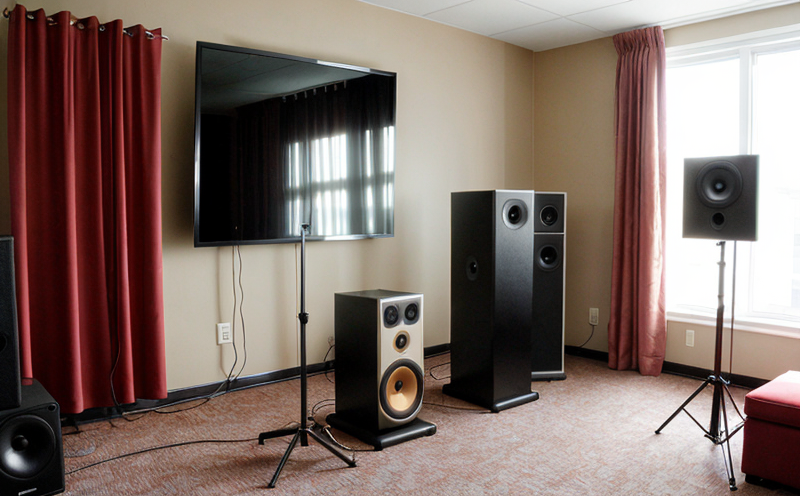ISO 389-7 Reference Hearing Threshold Testing
The ISO 389-7 reference hearing threshold testing is a critical procedure in acoustics, vibration, and noise testing that evaluates the auditory sensitivity of individuals. This test is essential for ensuring the safety and comfort of workers exposed to various sound levels across different industries such as manufacturing, construction, and aviation.
The ISO 389-7 standard specifies methods for determining reference hearing thresholds using audiometers with a frequency range from 250 Hz up to at least 8 kHz. The test is designed to assess the quietest sounds that can be heard by an individual under specified conditions. Compliance with this standard ensures that employers and manufacturers are meeting regulatory requirements and providing a safe working environment.
The testing process involves several steps, including preparation of the subject, calibration of the audiometer, administration of pure tone stimuli at various frequencies, and recording of the thresholds. The subject is typically seated in a sound-treated booth wearing headphones or ear inserts. The audiometer generates pure tones with adjustable levels, which are presented to one ear at a time.
The reference hearing threshold is defined as the level of a pure tone at which an individual can just detect it 50% of the time. This value provides a standardized measure for comparing auditory sensitivity between different subjects and under various conditions. The test is conducted in quiet environments, free from external noise interference to ensure accurate results.
For quality managers and compliance officers responsible for ensuring workplace safety, this testing helps identify individuals who may require additional hearing protection or adjustments to their work environment. R&D engineers benefit from the data generated by ISO 389-7 tests in developing quieter equipment and processes that comply with international standards. Procurement personnel can use the results to select suppliers who adhere to these stringent testing protocols.
The test is particularly relevant for industries where noise exposure is a concern, such as manufacturing plants, construction sites, and aviation facilities. By adhering to ISO 389-7, companies demonstrate their commitment to worker health and safety, which can lead to improved productivity and reduced healthcare costs associated with hearing loss.
The standard also plays a crucial role in the design of personal protective equipment (PPE) that includes noise-canceling earmuffs or earplugs. By using ISO 389-7 data, manufacturers can calibrate their products to effectively reduce sound levels while maintaining comfort and functionality.
Why Choose This Test
The ISO 389-7 reference hearing threshold test is a preferred choice for several reasons:
- Regulatory Compliance: Adherence to international standards ensures compliance with laws and regulations related to occupational health and safety.
- Standardized Measurements: The use of standardized procedures guarantees consistent and reliable results across different testing environments and operators.
- Precision and Accuracy: Advanced audiometers used in this test provide precise measurements that are crucial for accurate evaluation of auditory sensitivity.
- Interoperability: Results from this test can be easily shared between different facilities and countries, facilitating international collaboration on occupational health issues.
By choosing ISO 389-7 reference hearing threshold testing, organizations demonstrate their commitment to worker safety and well-being. This not only enhances the reputation of the company but also contributes significantly to reducing the incidence of noise-induced hearing loss in the workforce.
International Acceptance and Recognition
- Auditory Research: The ISO 389-7 standard is widely accepted by audiological research institutions worldwide. Its standardized methods facilitate collaborative studies on hearing sensitivity across different populations.
- Occupational Health: Numerous occupational health organizations, including the World Health Organization (WHO) and national labor bodies, recommend compliance with this standard to protect workers from noise-induced hearing loss.
- Product Development: Many international manufacturers incorporate ISO 389-7 standards into their product development processes. This ensures that end products meet global safety and comfort expectations.
The broad recognition of ISO 389-7 underscores its importance in the field of acoustics, vibration, and noise testing. Its adoption by various sectors highlights its value as a robust tool for assessing auditory sensitivity across diverse environments.
Environmental and Sustainability Contributions
The ISO 389-7 reference hearing threshold test contributes to environmental sustainability in several ways:
- Eco-friendly Design: By ensuring that equipment and processes are quieter, manufacturers can reduce noise pollution, which is beneficial for both human health and the environment.
- Resource Efficiency: Quieter machinery typically operates more efficiently, leading to reduced energy consumption and lower carbon footprints. This aligns with broader sustainability goals of industries.
- Hazard Reduction: Compliance with ISO 389-7 standards helps in minimizing the risk of noise-induced hearing loss among workers, thereby reducing healthcare costs for both employers and employees.
The standard's emphasis on precision and accuracy also supports sustainable practices by ensuring that resources are used optimally. By leveraging this test, companies can contribute to a healthier planet while maintaining high standards of occupational safety.





